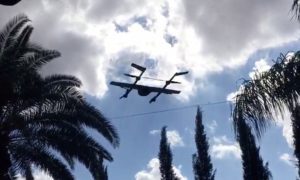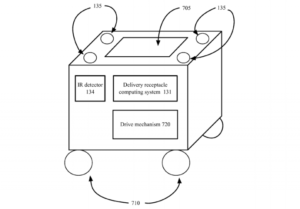 Google’s parent company, Alphabet, has filed a patent for a “delivery receptacle” to help with drone delivery.
Google’s parent company, Alphabet, has filed a patent for a “delivery receptacle” to help with drone delivery.
The patent, which Reuters reported was filed on Tuesday, calls for a delivery receptacle to take packages the last few steps to a secure location – the equivalent of your friendly FedEx driver leaving the package in the garage instead of on the porch.
Stating that “Unmanned, aerial delivery devices may be problematic for delivery to users,” the patent describes several complicated scenarios for overcoming some of the obvious flaws with drone delivery – while drones may be an excellent solution for covering most of the distance between a warehouse and a consumer, they lack some of the decision making skills for big dog avoidance, package safety, and signature requirement that your average delivery driver can provide.
…For example, leaving the package on the front porch of a busy street address may make it more likely that the package is stolen. Detailed delivery instructions to an unmanned aerial delivery device may be difficult for the limited vision system of the aerial delivery device to interpret. Thus, conventional aerial delivery device methods do not allow for safe, secure delivery of packages to delivery locations.
Google doesn’t have all of the details of their solution to the problem worked out. The 21 page patent document gives numerous scenarios for different types of delivery locations and leaves a number of the details of the idea undefined. But in short, as the simplest of the patent’s flowcharts describes, the process goes like this:
1.) Delivery receptacle identifies that a package is received
2) Delivery receptacle transports package to secure location
3) Delivery receptacle alerts user of package delivery.
The “delivery receptacle,” described in the figure below, will communicate with the delivery drone and with the consumer with infrared beacon transmitters.  How the receptacle travels to the drone and then to its ultimate secure location, though, is left up to the imagination:
How the receptacle travels to the drone and then to its ultimate secure location, though, is left up to the imagination:
The delivery receptacle may utilize wheels, rotors for flying, articulated legs, or any suitable means for propulsion or locomotion. The delivery receptacle may proceed to a desired location by rolling, walking, flying, or via any suitable propulsion.
The new patent provides more questions than it answers, as it clearly points out some of the flaws in the concept of unmanned delivery. But Tuesday’s patent filing does demonstrate that Google is working on the problem, and expecting Project Wing to take flight sometime soon.
Miriam McNabb is the Editor-in-Chief of DRONELIFE and CEO of JobForDrones, a professional drone services marketplace, and a fascinated observer of the emerging drone industry and the regulatory environment for drones. Miriam has penned over 3,000 articles focused on the commercial drone space and is an international speaker and recognized figure in the industry. Miriam has a degree from the University of Chicago and over 20 years of experience in high tech sales and marketing for new technologies.
For drone industry consulting or writing, Email Miriam.
TWITTER:@spaldingbarker
Subscribe to DroneLife here.







As a student in the Emergency Management Leadership Program at Adler University, the need for an Emergency Management Alert System has become quite clear.
I envision drone technology that could deliver emergency alert messages in multiple languages to necessary regions. This could be varied and loud enough that it would be taken serious.
Is this technology creation and usage on the horizon?